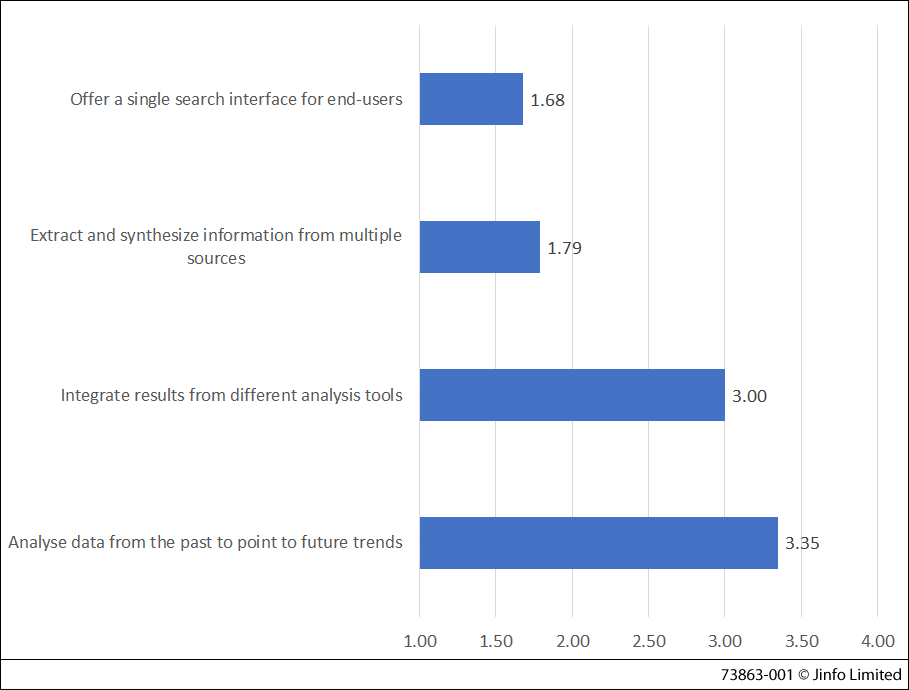 Early results reveal core requirements for content discovery
Early results reveal core requirements for content discovery
Jinfo Blog
10th April 2017
Abstract
The early results of Jinfo's survey on information discovery indicate that a top priority for such systems. Yet, underneath the core requirements, we see a wide range of user needs for discovery.
Item
Early results of Jinfo's survey on information discovery (partcipate now - 10 minutes) are already providing some insights on how discovery systems are perceived in enterprise settings. The survey gathers data about:
- Priorities and needs for discovery
- Tools in use or under consideration
- Biggest challenges in implementing effective discovery.
In one key question, respondents are asked to rank the importance of four capabilities of an effective discovery system. The early respondents indicate that there are two critical, and perhaps interdependent, requirements.
As shown in Figure 1, the capability to offer users a single search interface is essentially tied in importance with the capability to extract and synthesise information from multiple sources.
Figure 1: Two features are tied for top ranking of discovery capabilities
In addition, the initial responses provide insights about the variety of user needs which drive the tools and approaches for effective discovery.
Improving findability
One priority is the capability to enable access to both internal and external content sources, making it easier for users to mine all the available resources.
Some respondents note needs for search precision and customisable relevance ranking across results sets.
For others, robust authentication capabilities to enable immediate access to multiple full-text sources is key.
All of these indicate that enabling content findability for users is a key goal for discovery systems.
Enabling analysis
Some respondents focus their comments on the export of content for additional manipulation. This includes exporting content and datasets to Microsoft Excel and other tools.
Others identify the ability to create visualisations of quantifiable content sets (e.g. comparing use of words over time or across types of content).
In some cases, the goal is to enable in-depth comparison of internal transactional data against external data. These capabilities point to the importance of enabling sophisticated analysis of content and data.
These responses indicate that although providing users with unified access to the right content sets is a necessary first step, it may not be sufficient. There is also strong user demand for better analytical tools to draw insights from the relevant content.
Your participation is invited
- Have you already implemented a system which enables user access to multiple content sources through a single interface, or are you evaluating options?
- Are you seeing a growing interest in content analysis tools from users?
- Does your organisation have similar needs to those noted here, or are you addressing other kinds of user requirements?
Wherever your current context, I invite you to take 10 minutes to complete the survey now. If you provide a valid email address at the end of the survey, you'll receive a copy of the final results to thank you for your participation.
The survey is designed to uncover useful data not only about organisational needs but also about which services and tools are being evaluated or chosen to meet those needs.
I look forward to bringing you an update on the current landscape for discovery systems in enterprise settings at the close of the research.
- Blog post title: Early results reveal core requirements for content discovery
- Link to this page
- View printable version
- There's Much More to Search & Discovery than Google
Tuesday, 10th May 2016 - From Decision-Making to Discovery Services
Friday, 12th February 2016
- Jinfo survey - exploring discovery services - 2017
Tuesday, 30th May 2017 - Market landscape - discovery systems
Thursday, 28th April 2016
Register for our next Community session:

Transforming knowledge management at BASF – GenAI and the evolution of QKnows
10th December 2025
Latest on our YouTube channel:
Read on the Blog:
December 2025 update
3rd December 2025
- Jinfo wins CILIP’s inaugural “McFarlane & Ward Information Management” award
4th December 2025 - December 2025 update
3rd December 2025 - Review of Matchplat – combining AI with traditional industry code searching
27th November 2025
- Team roles and AI (Community) 26th February 2026
- Team demand and AI (Community) 22nd January 2026
- Transforming knowledge management at BASF – GenAI and the evolution of QKnows (Community) 10th December 2025
